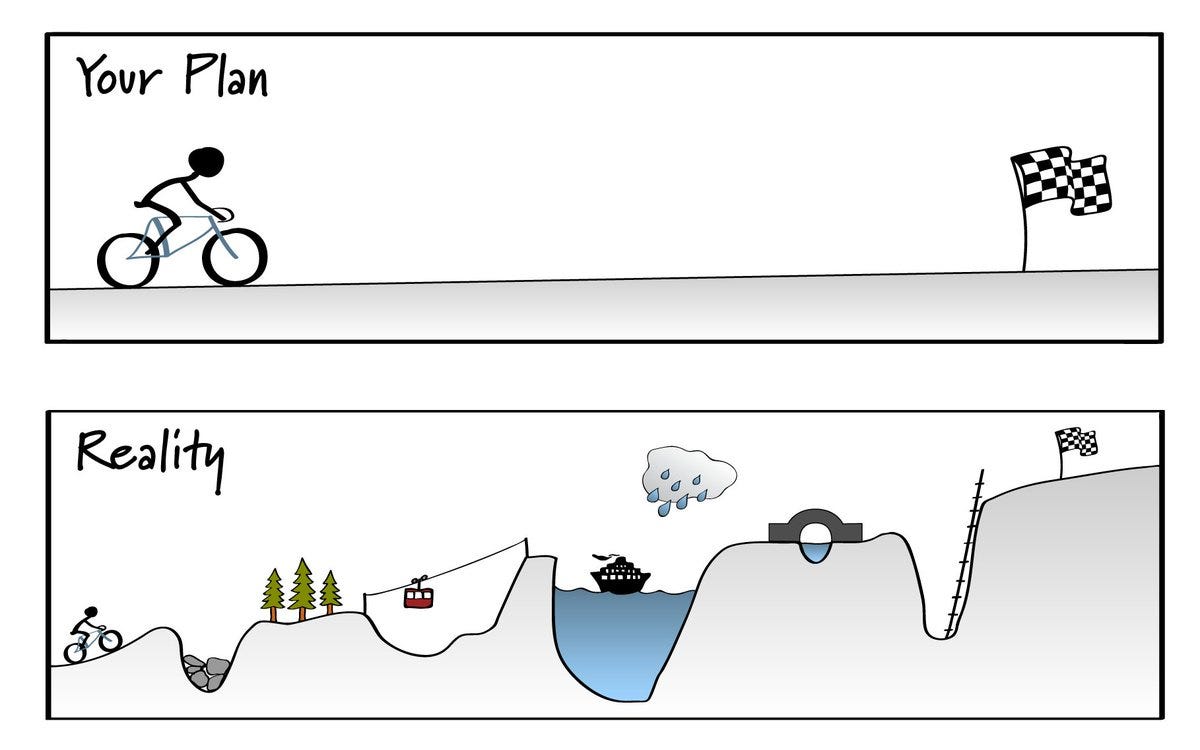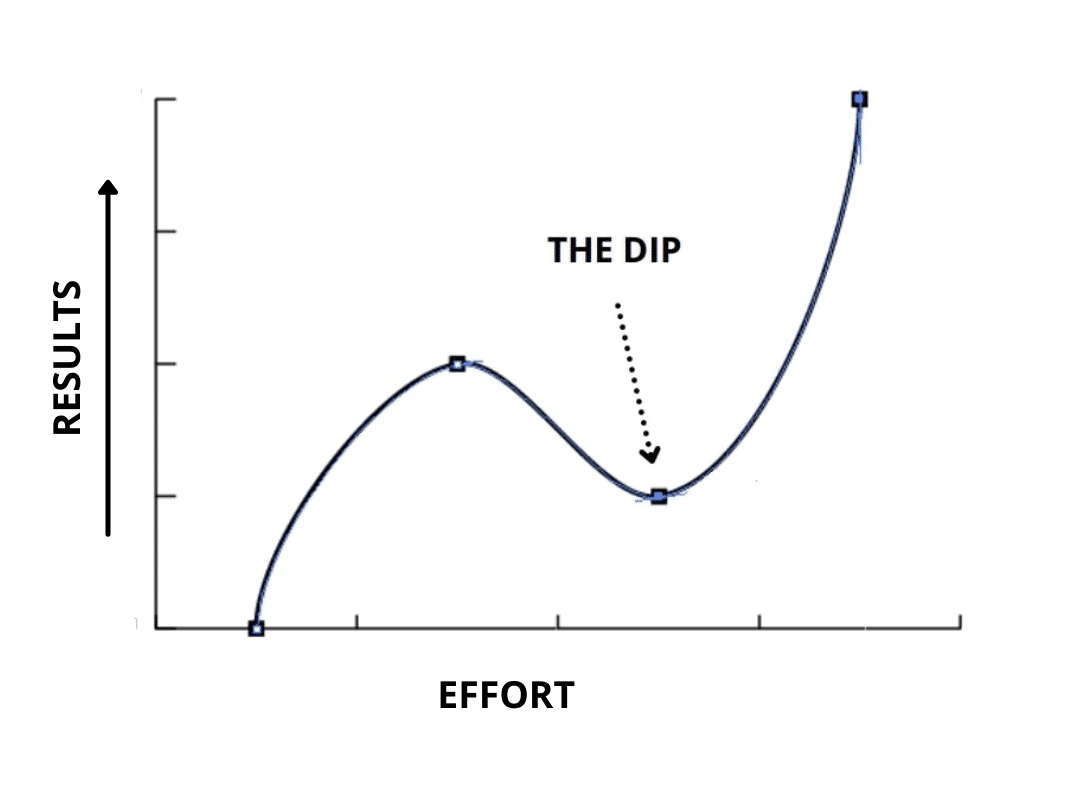The map vs the territory: why your life plan should be written in pencil
Discover why a flexible life plan beats both rigid goal-setting and aimless wandering and learn to navigate uncertainty while staying true to your values and instincts.
The most successful people I know have ditched more life plans than you could ever make. They've transitioned from law to pottery and from MBA programs to food trucks. They've deleted carefully crafted five-year spreadsheets to chase opportunities that didn't exist when they started planning. Yet, these serial plan abandoners seem to lead intentional and fulfilling lives.
Many people are concerned about the direction they should take in life. This reminds me of the famous exchange in Alice in Wonderland when Alice asks the Cheshire Cat which path she should take. "That depends a good deal on where you want to go," the Cat replies. When Alice admits that she doesn't care, the Cat grins and says, "Then it doesn't matter which way you go." What Lewis Carroll didn't mention is that we all need to start walking down some path to experience and discover what we actually want.
As a psychologist, I've had many existential discussions with clients who feel stuck in lives that don't quite fit them. They remain in unfulfilling jobs that feel like an ill-fitting suit, convinced that their costly higher education programs require them to do so. Some cling to decade-old dreams like security blankets while others drift through their days with no direction, wondering why nothing feels meaningful.
If you're reading this and you’re simultaneously afraid of change and dissatisfied with your current situation, you're not alone.
The map isn't the territory
The brilliant scientist Alfred Korzybski gave us this elegant metaphor: "The map is not the territory." Your life plan—your map—is simply a representation of where you think you want to go. It's not the actual journey, with its unexpected detours, surprise road closures, and those delightful discoveries you'd never find if you weren't willing to get a little lost.
Why you need a map
From helping people navigate life transitions, I've learned that having no plan is like trying to sail without a rudder. You might occasionally catch favorable winds, but you'll mostly drift in circles at the mercy of every current and storm. Without direction, every choice feels arbitrary, every setback feels catastrophic, and every day blends into the next in a gray blur. When you’re indecisive, life will make choices for you, and there’s a good chance you won't like the outcome.
But here's the paradox that trips up so many people: clinging too tightly to your plan can be just as paralyzing as having no plan at all.
The tyranny of the perfect plan
Meet Carol (not her real name), a lost 32-year-old who came to me because she felt "behind in life." She'd crafted the perfect ten-year plan at 22: graduate school by 24, dream job by 26, marriage by 28, house by 30, kids by 32. When real life refused to follow her timeline—a career pivot here, a relationship that didn't work out there—she felt like a failure. Her map had become a prison.
The problem wasn't that Carol had a plan; it's that she treated it like a contract with the universe rather than what it actually was: a working hypothesis about what might bring her fulfillment.
Why planning beats wandering
Research in positive psychology consistently shows that people with goals and direction report higher life satisfaction than those who drift without purpose. But here's the nuance: it's not about achieving specific outcomes; it's about the process of intentional living.
When you create a life plan, you're forced to clarify your values, identify what matters to you, and make conscious choices rather than defaulting to whatever happens. Even if you end up somewhere completely different, the act of planning develops your decision-making muscles and self-awareness.
Think of your life plan as a GPS, not a rigid itinerary. When you miss a turn or encounter unexpected construction, a good GPS recalculates. It doesn't shut down or berate you for not following the original route perfectly.
The art of flexible planning
The secret sauce isn't abandoning plans or white-knuckling through them regardless of changed circumstances. It's developing what psychologists call "cognitive flexibility"—the ability to adapt your thinking and behavior when situations change.
Here's how to plan like a project manager:
Start with your values or intent, not your outcomes. Instead of "I want to be a CEO by 40," try "I want to create value and lead others in meaningful work." Values are portable; specific jobs aren't.
Build in pivot points. Schedule regular check-ins with yourself every few months. Are you still excited about your direction? What has changed? What have you learned about yourself?
Distinguish between process and outcome goals. You can control showing up, putting in effort, and making thoughtful choices. You can't control whether the universe cooperates with your timeline. If you think your intent is right, fully commit while detaching yourself from the outcomes to focus on your efforts.
Practice the art of strategic quitting
Everything that’s worth doing seems worthless and frustrating at some point. But how do you know when to quit, and is quitting ever wise?
Sometimes, admitting that something isn't likely to work and choosing a different path early on is the most courageous thing you can do. The concept of "the Dip," as explained by bestselling author and marketing guru Seth Godin, is particularly useful. The Dip is the difficult period in any worthwhile pursuit when initial excitement gives way to obstacles, slow progress, and frustration. Most people give up at this point, but Godin argues that those who push through the dip ultimately succeed. The Dip acts as a filter. If the goal is meaningful, persevering leads to exponential rewards.
However, not every dip is worth the struggle. Some paths lead to dead ends or cliffs. The smart, strategic move is to recognize this early on, quit, and refocus your efforts where perseverance will pay off. Never quit at the dip. Grit it out and push through. Hold on when others have let go. The odds of success are exponentially higher at this stage. Many people give up as soon as they hit the dip. If you're the type of person who keeps switching from idea to idea, you should try persevering longer than you normally would. True success goes to those who obsess. Seth Godin uses the example of a woodpecker that can tap twenty thousand times on a thousand trees and get nowhere, yet still be busy. Alternatively, it can tap twenty thousand times on one tree and find dinner.
Extraordinary benefits accrue to the tiny minority of people who are able to push just a tiny bit longer than most. Extraordinary benefits also accrue to the tiny majority with the guts to quit early and refocus their efforts on something new. — Seth Godin
Adopt a beginner’s mind
There's an old Zen story my teacher told me about a student who visits a master, eager to learn. The master begins pouring tea into the student's cup, continuing even as it overflows. "Stop!" cries the student. "The cup is full!" The master smiles: "Yes. And like this cup, you are full of your own ideas and opinions. How can I teach you until you first empty your cup?"In order to make space in our mind, we must be at peace with facing our existential void with serenity and detachment. This means letting go of expectations, and ego-driven outcomes.
In Zen, “beginner’s mind” (Japanese: shoshin) means approaching each moment, task, or person with openness, curiosity, and the absence of preconceptions—like how a beginner naturally looks at things fresh. It’s the opposite of the “expert’s mind,” which tends to narrow down to what it already knows. Zen teachers stress beginner’s mind because even long-time practitioners can get stuck in habits, pride, or assumptions, which blocks true insight. Keeping beginner’s mind means staying receptive and alive to reality as it is, rather than filtered through the weight of past knowledge, intellect or ego.
Trust Your Inner Compass
The same principle applies to life planning. Sometimes, we're so attached to our current plans that we can't see new possibilities or hear our inner wisdom. Here's something that might surprise you: Your gut instincts are often more accurate than your detailed plans, but only if you're present enough to listen to them.
That persistent feeling that something isn't quite right? The unexpected excitement about an opportunity that doesn't fit your master plan? These aren't bugs in your system—they're features. Your unconscious mind is constantly processing information and picking up patterns that your conscious mind hasn't caught up to yet.
But here's the catch: this inner compass only works when you're fully present in the moment, not lost in anxiety about future outcomes or regret about past choices. Mindfulness isn't just about meditation cushions—it's about developing the capacity to sense what's actually happening right now, including the subtle signals your body and intuition are sending you.
Embracing the beautiful mess
Life is fundamentally uncertain, and that's not a bug—it's a feature. The uncertainty that terrifies you is the same force that makes growth, surprise, and joy possible. Every meaningful change requires stepping into the unknown, and every unknown holds both risks and possibilities.
The goal isn't to eliminate uncertainty (impossible) or to stumble through it blindly (unwise). It's to develop what psychologists call "uncertainty tolerance"—the ability to remain curious and open when you can't predict what comes next. This is where mindfulness becomes your secret weapon: when you can stay present with discomfort instead of immediately reaching for the false comfort of rigid plans, you create space for authentic responses rather than reactive ones.
Think of it this way: when you're fully present, you can feel whether you're moving toward expansion or contraction, toward energy or depletion. Your body knows before your mind does whether a choice aligns with your deepest values.
Your next step
If you're feeling stuck between the safety of the familiar and the terror of the unknown, start small. You don't need to blow up your entire life or commit to a rigid master plan. You just need to take one conscious step in a direction that feels aligned with who you're becoming.
Remember: the point of having a map isn't to follow it perfectly. It's to give you enough confidence to start walking, knowing you can adjust course as you learn more about both yourself and the territory you're exploring.
The territory is waiting. And it's far more interesting and challenging than any map could ever capture.




We may think that we have wasted many years until we realize our soul's true calling, but we could see them as training, like Carl Jung suggested. They are the foundations for finding "our passion", which may be evanescent until is not anymore. I'm pretty sure that the majority of us, human fellows, have had that sudden insight where we go: "This job makes me so unhappy. I'll quit and work on my dream instead". And then nothing happens.
I love your call to action and dive into the unknown philosophy in this article Rob. It hits home and it hits hard. It really takes a lot of, lets say, free will and determination to shrug off the years old inertia from our training period and start building something new. The Old Dream.
Like that Rumi quote: "The path appears as we walk it". We need to take the first step.
I appreciate the Buddhist teachings on impermanence and ever changing nature of reality. Don't grasp it, it may not last. It applies perfectly to our old selves and old jobs. Old and dangerous comfort zones.
First steps shall be taken!
Thanks for the writing Rob, I appreciate.